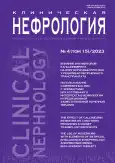Difficulties in diagnosing and treating recurrent aHUS in a modern hospital setting
- Authors: Popov S.V.1,2, Yesayan A.M.3, Guseynov R.G.1,4, Perepelitsa V.V.1, Vorobyova O.A.5, Sadovnikova A.A.1
-
Affiliations:
- St. Petersburg St. Luke Clinical Hospital
- S.M. Kirov Military Medical Academy
- Pavlov University
- St. Petersburg State University
- OOO National Center for Clinical Morphological Diagnostics, St. Petersburg
- Issue: Vol 15, No 4 (2023)
- Pages: 28-33
- Section: Clinical case
- URL: https://bakhtiniada.ru/2075-3594/article/view/257763
- DOI: https://doi.org/10.18565/nephrology.2023.4.28-33
- ID: 257763
Cite item
Abstract
Background. Atypical hemolytic uremic syndrome (aHUS) is a chronic systemic disease of genetic origin, which is based on uncontrolled activation of the alternative complement pathway, leading to generalized thrombus formation in the microvasculature (complement-mediated thrombotic microangiopathy - TMA). A typical triad of aHUS symptoms includes consumptive thrombocytopenia, nonimmune hemolytic anemia, and acute kidney injury. The predominant damage to the kidneys is probably associated with the increased sensitivity of the fenestrated glomerular endothelium to such damage. At the moment, the diagnosis of aHUS is one of the diagnoses of exceptions and does not have specific pathognomonic signs. It is established on the basis of the clinical picture of the disease after excluding other forms of TMA, both primary and secondary.
Objective. Demonstration of the difficulties of diagnosing and treating aHUS using a clinical example.
Description of the clinical case. In patient I., 27 years old, since 2016, proteinuria up to 1 g/day with “empty” urinary sediment and episodes of increased blood pressure were recorded, which was interpreted as chronic glomerulonephritis. Symptoms characteristic of aHUS: anemia, decreased platelet levels, and acute kidney injury of the graft developed in the patient in the early postoperative period. However, nonspecific symptoms were regarded as consequences of significant blood loss during surgery and delayed graft function. Discussion of the diagnosis of TMA became possible primarily due to the results of a morphological study of the graft tissue and was difficult due to the development of postoperative complications and the current septic condition.
Conclusion. It is extremely important for doctors to be aware of the disease and the possibilities of its diagnosis, because a timely confirmed diagnosis of aHUS and the initiation of targeted therapy can significantly improve or completely restore the function of the affected organs.
Full Text
##article.viewOnOriginalSite##About the authors
Sergey V. Popov
St. Petersburg St. Luke Clinical Hospital; S.M. Kirov Military Medical Academy
Email: doc.popov@gmail.com
ORCID iD: 0000-0003-2767-7153
Dr.Sci. (Med.), Professor, Chief Physician of St. Petersburg St. Luke Clinical Hospital, Head of the Center for Endoscopic Urology and New Technologies, Professor at the Department of Urology, S.M. Kirov Military Medical Academy, Head of the Department of Urology, St. Petersburg Medical and Social Institute
Russian Federation, St. Petersburg; St. PetersburgAshot M. Yesayan
Pavlov University
Email: essaian.ashot@gmail.com
ORCID iD: 0000-0002-7202-3151
Dr.Sci. (Med.), Professor, Head of the Department of Nephrology and Dialysis, Faculty of Postgraduate Education, Pavlov University, Chief External Expert in Nephrology of the Northwestern Federal District of the Russian Federation
Russian Federation, St. PetersburgRuslan G. Guseynov
St. Petersburg St. Luke Clinical Hospital; St. Petersburg State University
Email: rusfa@yandex.ru
ORCID iD: 0000-0001-9935-0243
Cand.Sci. (Med.), Deputy Chief Physician for Scientific Activities, St. Petersburg St. Luke State Clinical Hospital, Teaching Assistant at the Department of Hospital Surgery, St. Petersburg State University
Russian Federation, St. Petersburg; St. PetersburgVitaly V. Perepelitsa
St. Petersburg St. Luke Clinical Hospital
Email: perepelitsa_vit@mail.ru
ORCID iD: 0000-0002-7656-4473
Cand. Sci. (Med.), Urologist, St. Petersburg St. Luke Clinical Hospital
Russian Federation, St. PetersburgOlga A. Vorobyova
OOO National Center for Clinical Morphological Diagnostics, St. Petersburg
Email: olvorob70@gmail.com
Cand.Sci. (Med.), Pathologist, Head of the Department of Pathology of Native and Transplanted Kidneys, National Center for Clinical Morphological Diagnostics
Russian FederationAnastasia A. Sadovnikova
St. Petersburg St. Luke Clinical Hospital
Author for correspondence.
Email: stenia1407@mail.ru
ORCID iD: 0009-0004-9544-7944
Nephrologist, St. Petersburg St. Luke Clinical Hospital
Russian Federation, St. PetersburgReferences
- Ariceta G., Besbas N., Johnson S., et al. Guideline for the investigation and initial therapy of diarrheanegative hemolyticuremic syndrome. Pediatr. Nephrol. 2009;24:687–96.
- Barbour T., Johnson S., Cohney S., et al. Thrombotic microangiopathy and associated renal disorders. Nephrol. Dial. Transplant. 2012;27:2673–85.
- Fakhouri F., Zuber J., Fromeaux-Bacchi V., Loirat C. Haemolytic uraemic syndrome. Lancet. 2017;390:681–96.
- Yan K., Desai K., Gullapalli L., et al. Epidemiology of atypical hemolytic uremic syndrome: A systematic literature review. Clin. Epidemiol. 2020;12: 295–305.
- Sullivan M., Erlic Z., Hoffmann M.M., et al. Epidemiological Approach to Identifying Genetic Predispositions for Atypical Hemolytic Uremic Syndrome. Hum. Genet. 2010. https://doi.org/10.1111/j.1469-1809.2009.00554.x
- Fakhouri F., Delmas Y., Provot F., et al. Insights from the use in clinical practice of eculizumab in adult patients with atypical hemolytic uremic syndrome affecting the native kidneys: an analysis of 19 cases. AJKD. 2013. http://dx.doi.org/10.1053/ j.ajkd.2013.07.011
- Stea E.D., Skerka C., Accetturo M., Pesce F. Case report: Novel FHR2 variants in atypical Hemolytic Uremic Syndrome: A case study of a translational medicine approach in renal transplantation. Front. Immunol. 2022. 10.3389/fimmu.2022.1008294' target='_blank'>https://doi: 10.3389/fimmu.2022.1008294
- Tang Zh. Ch., Hui H., Shi Ch., Chen X. New findings in preventing recurrence and improving renal function in AHUS patients after renal transplantation treated with eculizumab: a systemic review and meta-analyses 2023. Renal Failure. 2023. 10.3389/fimmu.2022.1008294' target='_blank'>https://doi: 10.3389/fimmu.2022.1008294
Supplementary files










